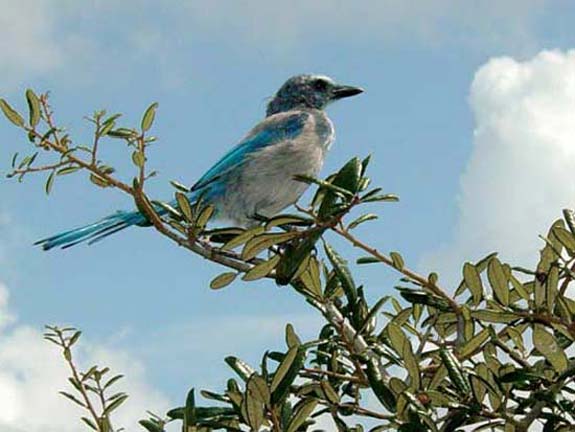 This Florida scrub-jay was captured on camera at the District’s Hálpata Tastanaki Preserve in Marion County by Will Van Gelder, senior land management specialist.
This Florida scrub-jay was captured on camera at the District’s Hálpata Tastanaki Preserve in Marion County by Will Van Gelder, senior land management specialist.
The Florida scrub-jay and other threatened and endangered species now have an improved habitat thanks to restoration projects at the District’s Hálpata Tastanaki Preserve in Marion County.
“This is a successful habitat enhancement project that has brought the population from about 3 to 100 Florida scrub-jays at Hálpata Tastanaki since 1997,” said Mary Barnwell, senior land management specialist for the District. “It’s very gratifying and exciting.”
Measuring 10–12 inches in length and weighing only about 2½ ounces, the Florida scrub-jay resembles the more common blue jay. Similar in color, the Florida scrub-jay is gray and blue, but lacks the crest, black collar and the white wing bars like that of the blue jay.
The Florida scrub-jay only occurs in peninsular Florida and, historically, in about 39 counties. However, the Florida scrub-jays have shown a drastic decline in population since 1990. As a result, the U.S. Fish & Wildlife Service requested assistance from state agencies in restoring habitat and maintaining protection for these birds.
The Florida scrub-jays’ habitat is a 1,650-acre special protection area located on the eastern portion of the Hálpata Tastanaki Preserve.
Prior to District ownership, the area consisted of native grassland with sparse longleaf pine trees. It had been transformed by logging and conversion to Bahiagrass pasture. The replacement of native grasses and active suppression of high intensity, natural fires led to an increase in scrubby oaks on the area.
Over time, this shift in vegetation produced habitat suitable for Florida scrub-jays, which started to colonize the area as their preferred habitat became either developed or too overgrown with sand pine trees.
Florida scrub communities occur on ancient sand dunes with well-drained elevation. They thrive in areas with small oak trees that cover about 60–70 percent of their habitat; the remaining are open sand areas. A “scrub” community refers to the plants and animals that live in an area characterized by scrub oaks species, rosemary shrubs, rusty lyonia shrubs, sand pine trees, saw palmettos and prickly pear cactuses.
Florida scrub-jays exist only in Florida and they do not migrate like other birds. Rather, they create distinct territories within their scrub and typically stay within about four to six miles of it throughout their lives.
The District manages Florida scrub-jay habitats primarily through mechanical alteration, sand pine tree harvests (logging) and controlled burns.
Mechanical alteration includes mowing overgrown vegetation with the overall goal of achieving a habitat suitable for scrub-jays, which is shrubs and oaks approximately three to nine feet in height. Targeted scrub oak trees are mowed to their trunk, reducing their height and allowing them to resprout from their underground roots. Additionally, mowing facilitates a thorough and clean controlled burn.
Controlled burns rejuvenate the vegetation and encourage seeding and flowering, increase wildlife habitat, recycle nutrients back into the soil and eliminate any unwanted and harmful species. Burns also help prevent the accumulation of dense vegetation that can lead to uncontrollable wildfires, property damage and loss of life. Controlled burns are generally conducted in “management blocks,” which provide a protected area for the scrub-jays while another area is being burned.
Since 1995, the District has completed well over 3,000 acres of scrub restoration on a total of 14 District properties, including 525 acres of habitat improvement for scrub-jays at Hálpata Tastanaki Preserve.
Although scrub restoration projects vary in size and are always ongoing, it typically takes about two weeks to a month to complete a project. Land management staff work very closely with field maintenance staff to plan and execute a restoration.
“Field maintenance is essential to our projects,” said Barnwell. “We’re a team.”
Scrub communities are highly disturbed in Florida due to fire suppression, land conversion and invasive plants; therefore, land management is always working on restoration projects. Typically, mechanical manipulation is conducted only once, and thereafter fire is utilized to maintain the scrub at an early, manageable stage. However, in some cases, such as where wild lands and developed areas meet or in highly altered scrub habitats, mechanical methods may need to be conducted regularly at 5- to 8-year intervals. Controlled burns conducted in the scrub community, depending on the area, can range from every 5 to 20 years.
